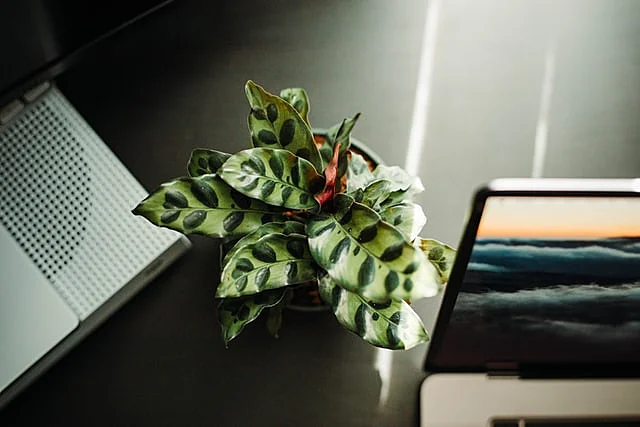Table of Contents
How To Care For Your Rattlesnake Plant
Calathea Lancifolia, commonly known as the Rattlesnake Plant, is a striking perennial who will add a splash of exotic colour to any room in your home.
Lancifolia’s main appeal lies in its stunning foliage, which features long, slender leaves with unusual wavy edges. The top sides of the leaves are a vibrant green, with gorgeous deeper green oblong spots.
Lancifolia gets even more exciting underneath with its lovely reddish purple undersides. The leaves can get very long, with the larger, more established plants reaching up to 30 inches (76cm).
Character
Calatheas are shade loving plants, making them ideal for the lower light areas of your household. While Calatheas are often considered a little tricky, fortunately for us, the beautiful Rattlesnake Plant is one of the more easy going and easy to care for varieties.
Praying
One of the most fabulous things about the Rattlesnake Plant is the way the leaves react to light and stand up, or pray’, at night.
Many people notice a rustling sound that accompanies the movement of the leaves, and it is thought that this is where the name rattlesnake’ comes from.
Water
While it’s super important not to overwater your houseplants (or your outdoor plants in pots), Lancifolia prefers not to completely dry out.
The best way to meet Lancifolia’s watering requirements is by checking the soil by pushing your finger into the top inch of soil.
If it’s dry, you can go ahead and water. Another great way to know when to water Lancifolia is by watching its leaves. If they begin to curl in from the edges, Lancifolia needs a big drink.
When you do water Lancifolia, a great method is to completely submerge the pot in a bucket of water.
This ensures the plant is completely soaked through (plus there is something so satisfying about watching all the air bubbling out!). After around ten minutes, take the pot out and let it drain completely.
If you keep your plant sitting in a saucer, make sure water doesn’t collect at the base of the pot, as Lancifolia doesn’t like wet or soggy feet and the roots will rot.
In general, Calatheas are considered one of those houseplants who do not tolerate tap water well. If possible, water Lancifolia with rain water or filtered water.
If this isn’t possible, you might like to consider purifying your water by leaving it out in the sun for 24 hours before applying it to your plants.
Soil
Lancifolia likes a soil mix that drains well but still retains some moisture. Two parts peat moss to one part perlite would be ideal to ensure both adequate drainage and water retention.
Light
Outdoors, Lancifolia prefers shade or dappled shade. Indoors, choose a bright position away from direct sunlight, and be careful if placing in widows as the glass can magnify the light and burn leaves very quickly.
Lancifolia will also tolerate lower light positions in your house, but keep in mind that it will grow far more slowly.
If you do need Lancifolia for a lower light area, a great tip is to have two plants and rotate them on a regular basis so they both get some sun.
The most fabulous thing about Lancifolia is that she will tell you if she likes her position, as too much sunlight will make her leaves curl up. If this happens don’t despair, just choose a shadier spot and the leaves will soon unfurl.
Temperature
Lancifolia is a tropical beauty originating from Brazil, so she loves warmer temperatures and humidity.
Around 65 – 75 degrees Fahrenheit (18 -25 degrees Celsius) is considered ideal, although Lancifolia can withstand far warmer temperatures than this, as long as she isn’t in direct sun.
For humidity, Lancifolia loves a light misting or a regular basis, or a tray of pebble water (you can place this under the pot, making sure the bottom of the pot is well clear of the water).
If you would like to become a next level plant parent, you may also wish to purchase a humidifier for your plants. These can be found at your local garden centre.
Propagation
Calathea are clumping plants which grow from subterranean compact rhizomes and are easily propagated.
First, remove your Lancifolia from its pot and carefully shake off the soil. The plants will be joined by a largish, white, rootlike stem under the soil. This is the rhizome, and is where the plants store their water and nutrients.
You can divide the plants simply by cutting the rhizome that joins them (about halfway between each plant). Before you do this, make sure each plant has a large enough root system to survive on its own (around 2 inches or 5 centimetres long).
Take your newly divided up plants and pot them back into soil, ensuring that the roots and the rhizome or completely under the surface of the soil.
Water in thoroughly, and then water sparingly every few days to keep moist, but not wet. Too much water will cause the roots and rhizome to rot.
Fertilizer/Repotting
Lancifolia will thrive on a balanced feed applied during the growing months (spring and summer). As it grows from rhizomes, Lancifolia also likes to have some space to spread out, and will benefit from repotting as it grows.
Consider moving up a pot size at the beginning of every spring. This would also be the ideal time for a soil refresh with some well composted soil.
Pests and Diseases
While fairly pest resistant, Lancifolia can succumb to the usual indoor pests such as spider mites and fungus gnats. You can remove these pests with a cotton swab dipped in rubbing alcohol, or by wiping the plant with a damp cloth.
There are also many commercial sprays available for the treatment of these pests.
Calathea are prone to a browning of the tips and edges of the leaves which is generally attributed to a lack of humidity.
You may notice a yellowing of the older leaves of your Lancifolia. This is a natural ageing and dying off process. Simply remove the leaves by cutting them off at the base.
Pets and Children
Lancifolia is generally considered to be non-toxic to pets and children.
Photo by Axel Vazquez on Unsplash


